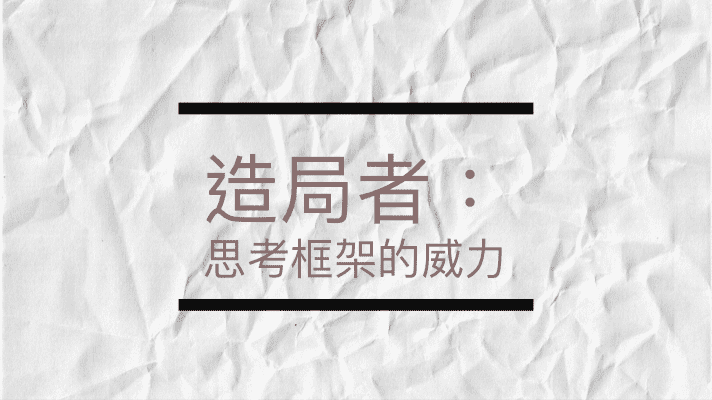Table of Contents
《造局者: 思考框架的威力》簡介
《造局者: 思考框架的威力》這本書有三位作者,包括《經濟學人》編輯Kenneth Cukier、英國牛津大學網路研究所教授Viktor Mayer-Schönberger、歐洲管理科技學院教授Francis de Véricourt。前兩位也合作過另一本知名著作《大數據》。
在近年一片AI熱潮中,不少人都會提出這個問題: 如果什麼事都交給AI,那麼人類要做什麼呢?其實,深入去思考會發現,AI做的只是數據分析、選項推薦,基於現有資料運作的工作,卻沒有「提出問題」的能力。AI可以幫助我們找出已知問題的解決方案,但我們實際是生活在不斷發展,天天有新問題發生的世界中。
即使在AI更加進步的世界中,不會被取代的工作將是收集、切換、使用不同的思考框架,來定義問題、或是定義著手的方向。合理的提出新的問題,告訴別人(或是AI)真正的問題是什麼,運用心智模型,創造局勢,便是所謂的「造局者」。這本書談的,便是如何運用「思考框架」,成為一個好的造局者。
詳細心得見以下。
什麼是思考框架?
人類的行為是基於推理結果,類似於模擬現實,我們透過想像去模擬各種情況,來評估行動的選項。因此一個人在思考中模擬世界所使用的模型,對其行為有深刻的影響。
需要做出重大決定的時候,你會發現自己的決定除了出於客觀邏輯,還會有一些更根本的理由,像是看待當下情境的視角、認定世界運作的方式。而這種潛藏的認知因素,就是由各種心智模型組成的。
我們如何理解世界,會受到我們「相信」世界如何運作所影響。
我們對世界的想像可以說是心智模型,而思考框架可以說是我們對問題和環境的整體認知,一部份心智模型的具體呈現。比如說,民主政體和專制政體,就是用於政府治理體制截然不同的兩種框架。思考框架是我們面對問題時思考的基礎。在生活中我們經常需要對未知的事物做出反應,人無法同時考慮所有可見的因素,因此我們的腦袋會試圖簡化所收集到的資訊,對當下情況做出預想和決策。也就是說,我們會使用一種思考框架評估不同的解決方案,當我們挑選的思考框架不同,視角就不同。一個方案是好或壞,使用不同思考框架的人可能會有截然不同的判斷。
人類的心智會透過思考框架來掌握重點、過濾雜訊,否則完整的資訊實在太過龐雜,只會讓人思考過載。靠著建立對世界的心智模型,才能讓我們覺得能夠掌握世界,知道自己該如何行動。
要是少了思考框架,我們就很難清楚的將自己的目標與價值觀,連結到可能的行動方案。
使用不同的思考框架會有如何不同的結果呢?一個例子是在伊波拉爆發時世界衛生組織(WHO)和無國界醫師(MSF)使用同樣的資料,卻得出完全不同的觀點: 在2014年伊波拉爆發時,WHO認為案例數不多,和過去的疫情類似,所以認為疫情只限於當地,不需要嚴格的國際間應對。MSF卻注意到幾個村莊空間距離較遠,因此認為資料不全,實際擴散一定已經超過資料所見,呼籲立刻採取嚴格措施。兩者一開始針鋒相對,最後證明了MSF是對的,這是後話。其實兩邊想法差異的主因是因為一開始的思考框架不同,在WHO的思考框架中,問題已經被簡化成沒有資料完整度出問題的可能性,MSF卻對資料抱持懷疑態度。
世界上有許多問題之所以棘手,就是因為人們使用的思考框架不同,看法也就不同。例如一國兩制的重點是一國、還是兩制?不同陣營的人就有不同答案。要不要戴口罩打疫苗?以公共衛生、健康為出發點,和以自由為出發點的人也有不同答案。
什麼是造局者?
思考框架不只一種。通常,我們會自然的檢視目標與情境來決定對的框架,甚至是修正現有框架。廣泛來說,應用思考框架的情境不出以下兩種:
- 在熟悉的情況中,使用思考框架減輕認知負擔,有效率的做出決定。
- 遇到新的情況,選擇新的框架以得出新的選項。
我們一般慣用的思考框架並不一定反映現實,例如歷史上有許多當時看起來合理後來卻被拋棄的思考框架,像是地球是平的。所以,尤其是在當面對的問題是屬於從未見過的情況時,建立或切換思考框架的能力顯得特別重要。如果我們在下決定前,刻意掌握用不同的心智模型去思考,發掘各種選項,套用預想能力,就有可能開創出新的局面。
「造局者」(framer),就是擅長建立思考框架的人,造局者知道如何選擇並應用思考框架,做為決定與行動的基礎。
倚靠思考框架,就能讓我們從個別的經驗中學習,找出通用的法則,也就能適用到其他情境、甚至是還未發生過的情境。
面對重大的挑戰,先有一開始的想法,接著能夠改變觀點,於是開闢新路、找出解答。這裡該讚賞的並不是新科技,而是人類的能力。
建立了正確的思考框架,也就解鎖了新的解決方案。
書中提到一個藥物研發突破的例子: 傳統的藥物研發的慣用手法是,針對過去有藥效的物質,試圖尋找分子指紋相似的物質,但這樣找出來的藥物容易有抗藥性。巴茲萊等學者使用新的思考框架重述了問題,將重點從尋找相似的分子結構,改為尋找期望的效果(可殺死細菌),並且使用AI來執行。
巴茲萊等人之所以能成功,要素之一就是掌握了一種認知自由。而他們擁有這種自由,並不是因為讀了哪本書、依循了什麼傳統、做了什麼顯然合理的事,而只是因為他們運用了一種全人類都擁有的獨特認知能力。
如何成為好的造局者?
要成為一個好的造局者,必須要盡可能使自己的可用框架多元化。
一個人心裡的思考框架愈多樣,就愈可能挑到更好的框架。
我們該追求的目標是框架的多元性: 培養差異、歌頌差異,而不是希望大家對世界都抱持同質的觀點。
好的造局者最常做的事就是在現有框架庫中切換框架 (Repertoire)。每個人都有自己的思考框架庫,庫存的豐富度會決定是否容易在特定情境下找到合適的框架。如果庫存的相似程度太高,也會造成難以適應新情況。因此,好的造局者必須不斷充實自己的框架庫,要有好奇心,透過「認知採集」(cognitiv foraging)收集越來越多的框架。什麼是認知採集?就是經常去看看別人如何建立對某個問題的思考框架,學習別人的做法。也可以是去尋找新的思考方式、了解新的觀點,積極探尋新的想法、體驗。
如果想當一位造局者,就必須見賢思齊:準備好放開心胸,接受新的觀點和新的思考框架。
當情境太特殊,沒有好的框架時,也要有勇氣跳進未知的領域,準備接受新概念。當面對新的問題,可以考慮借用其他領域的舊有框架或是試著發明新框架。
- 借用舊有框架調整 (Repurpose)
這是指借用其他領域的框架並且調整用法。比起從頭發明框架,這是一種有效率的方式,但也需要對於不同領域的好奇心、技巧與能力。
切換到另一個領域的框架庫、找出適合當下情境的新框架,就像是站在別人的肩膀上。
- 發明新框架 (Reinvent)
對於某些特別新的問題,實在沒有現有的正確框架存在,我們就必須靠自己設計出新的框架。能夠創造出新框架的人,會得到眾人讚賞,因為新的框架可以改變世界。像是愛因斯坦提出狹義相對論,就是為物理學創造出新的框架。
如何建立新的思考框架?
建立新的思考框架有三個要素∶因果思維、創造反事實、訂定正確的限制條件。
因果推理是人類的認知基礎。人類擅長找出模式,懂得類推,並且會將抽象化後的因果關係模型傳給其他人,因此才能夠超越較為低階的生物。
能把當下的情境轉為整體適用的抽象概念,會給人帶來極大的優勢。
創造反事實,可以是想像一個平行現實,稍微改變一下已知的世界。基本上就是去自問 「如果某個地方改變,會怎麼樣?」。
反事實就是讓我們能看得比現實更遠的方式。
雖然創造反事實很重要,但如果太脫離現實會有反效果。所以我們應該限制想像力讓反事實維持在可行的狀態,才不會太天馬行空。平行現實的想像必須是有助於實現目標,如果沒有目標僅僅只是隨意發明各種平行現實,結果通常是無意義的。
你得先選擇心智模型、選擇要有哪些限制,再用來思考各種反事實。
框架也就是界限,如果沒有界限,我們可能提出天馬行空的胡思亂想,很可能完全找不到真正有效的選項。
人類所建立的思考框架之所以有用,正是因為能讓我們的心智運作仍然有架構、有目的、有限度。可以說這個「框框」正是秘訣所在。
我們必須把注意力放在定義正確的限制上。軟性限制的選擇則是一門藝術,不過我們可以專注於符合三項原則的限制:
- 可變性原則: 專注在我們自己認為可以改變,或是我們可以影響的項目上。例如說針對要怎麼進城這樣的問題,我們會考慮要搭什麼交通工具,而不是考慮長出翅膀飛過去之類。
- 最小變動原則: 讓變動越少越好。正所謂簡單就是美,讓問題的條件看起來簡單,而不是非常複雜通常會比較好。相對於想像不存在的東西,把現實中已知存在的東西刪去可能更容易得多。
- 一致性: 限制條件不能互相矛盾。
我們應用各種限制條件,並不是為了創造出最多種不同的反事實,而是希望迅速找出效率最高、數量合理的選項;真正的目標是「縮小搜尋範圍」。
結論
當一個好的造局者並不容易。這份工作說起來簡單,做起來難。《造局者》這本書談了許多原則和方向,但思考框架這個概念本身,其實就可以說是抽象的框架。如何實踐、收集、切換思考框架,對每個人都是挑戰。
回到最初的討論,究竟人和AI有多大區別呢?或許思考框架的建立是個好的解答,但前提是人要願意負起責任,有勇氣和想像力,承擔這個角色。在未來,多數人能不能體認到思考的本質和重要性、致力於合理的定義限制條件?亦或是,多數人會陷入盲目消費內容的陷阱之中?這是另一個值得我們持續觀察、探討的問題。
謝謝你看完這篇文章。如果你喜歡我的文章,請追蹤Facebook粉專、Twitter、IG。
